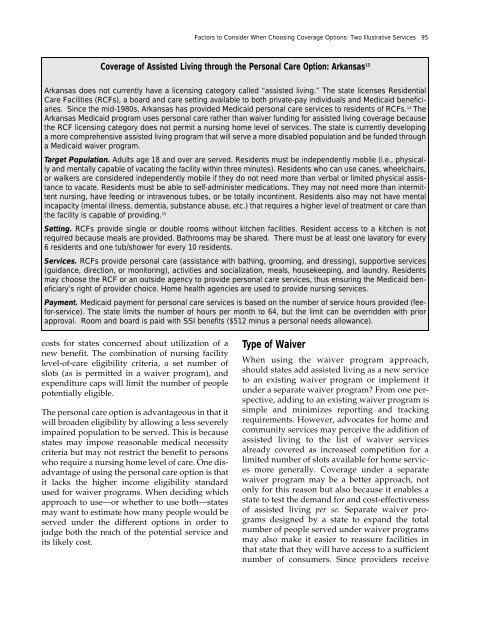Full PDF Version - ASPE - U.S. Department of Health and Human ...
Full PDF Version - ASPE - U.S. Department of Health and Human ...
Full PDF Version - ASPE - U.S. Department of Health and Human ...
- No tags were found...
You also want an ePaper? Increase the reach of your titles
YUMPU automatically turns print PDFs into web optimized ePapers that Google loves.
Factors to Consider When Choosing Coverage Options: Two Illustrative Services 95Coverage <strong>of</strong> Assisted Living through the Personal Care Option: Arkansas 13Arkansas does not currently have a licensing category called “assisted living.” The state licenses ResidentialCare Facilities (RCFs), a board <strong>and</strong> care setting available to both private-pay individuals <strong>and</strong> Medicaid beneficiaries.Since the mid-1980s, Arkansas has provided Medicaid personal care services to residents <strong>of</strong> RCFs. 14 TheArkansas Medicaid program uses personal care rather than waiver funding for assisted living coverage becausethe RCF licensing category does not permit a nursing home level <strong>of</strong> services. The state is currently developinga more comprehensive assisted living program that will serve a more disabled population <strong>and</strong> be funded througha Medicaid waiver program.Target Population. Adults age 18 <strong>and</strong> over are served. Residents must be independently mobile (i.e., physically<strong>and</strong> mentally capable <strong>of</strong> vacating the facility within three minutes). Residents who can use canes, wheelchairs,or walkers are considered independently mobile if they do not need more than verbal or limited physical assistanceto vacate. Residents must be able to self-administer medications. They may not need more than intermittentnursing, have feeding or intravenous tubes, or be totally incontinent. Residents also may not have mentalincapacity (mental illness, dementia, substance abuse, etc.) that requires a higher level <strong>of</strong> treatment or care thanthe facility is capable <strong>of</strong> providing. 15Setting. RCFs provide single or double rooms without kitchen facilities. Resident access to a kitchen is notrequired because meals are provided. Bathrooms may be shared. There must be at least one lavatory for every6 residents <strong>and</strong> one tub/shower for every 10 residents.Services. RCFs provide personal care (assistance with bathing, grooming, <strong>and</strong> dressing), supportive services(guidance, direction, or monitoring), activities <strong>and</strong> socialization, meals, housekeeping, <strong>and</strong> laundry. Residentsmay choose the RCF or an outside agency to provide personal care services, thus ensuring the Medicaid beneficiary’sright <strong>of</strong> provider choice. Home health agencies are used to provide nursing services.Payment. Medicaid payment for personal care services is based on the number <strong>of</strong> service hours provided (feefor-service).The state limits the number <strong>of</strong> hours per month to 64, but the limit can be overridden with priorapproval. Room <strong>and</strong> board is paid with SSI benefits ($512 minus a personal needs allowance).costs for states concerned about utilization <strong>of</strong> anew benefit. The combination <strong>of</strong> nursing facilitylevel-<strong>of</strong>-care eligibility criteria, a set number <strong>of</strong>slots (as is permitted in a waiver program), <strong>and</strong>expenditure caps will limit the number <strong>of</strong> peoplepotentially eligible.The personal care option is advantageous in that itwill broaden eligibility by allowing a less severelyimpaired population to be served. This is becausestates may impose reasonable medical necessitycriteria but may not restrict the benefit to personswho require a nursing home level <strong>of</strong> care. One disadvantage<strong>of</strong> using the personal care option is thatit lacks the higher income eligibility st<strong>and</strong>ardused for waiver programs. When deciding whichapproach to use—or whether to use both—statesmay want to estimate how many people would beserved under the different options in order tojudge both the reach <strong>of</strong> the potential service <strong>and</strong>its likely cost.Type <strong>of</strong> WaiverWhen using the waiver program approach,should states add assisted living as a new serviceto an existing waiver program or implement itunder a separate waiver program? From one perspective,adding to an existing waiver program issimple <strong>and</strong> minimizes reporting <strong>and</strong> trackingrequirements. However, advocates for home <strong>and</strong>community services may perceive the addition <strong>of</strong>assisted living to the list <strong>of</strong> waiver servicesalready covered as increased competition for alimited number <strong>of</strong> slots available for home servicesmore generally. Coverage under a separatewaiver program may be a better approach, notonly for this reason but also because it enables astate to test the dem<strong>and</strong> for <strong>and</strong> cost-effectiveness<strong>of</strong> assisted living per se. Separate waiver programsdesigned by a state to exp<strong>and</strong> the totalnumber <strong>of</strong> people served under waiver programsmay also make it easier to reassure facilities inthat state that they will have access to a sufficientnumber <strong>of</strong> consumers. Since providers receive
















